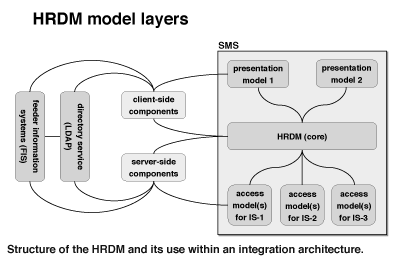
ERCIM News No.35 - October 1998

![]()
ERCIM News No.35 - October 1998
Contents and Use of a Healthcare Domain Reference Data Model
by Erich Leisch
Since 1996, a Healthcare Domain Reference Data Model (HRDM) is being developed in Crete by ICS-FORTH, Center for Medical Informatics and Health Telematics Applications, in the context of its efforts towards developing an integration strategy for geographically distributed heterogeneous autonomous healthcare information systems.
In the presented approach, integration is seen and understood in terms of access to information resources, and in terms of content, structure, and visualization of patient record segments, with the goal of creating a virtual patient record at a user’s workstation. The architecture is based on a Healthcare Domain Reference Data Model (HRDM). Meta-data are used to describe the location, semantics, access mechanisms, and presentation models of healthcare information and the systems that are used to manage it. Furthermore, meta-data are used to describe workflow procedures, thus enabling functional integration. Based on the meta-data kept in the HRDM and in directories, services for data mediation, distributed directory access, and workflow management can be provided or supported.
It was not a goal to allow updates of patient record segments through the virtual patient record interface, because this would probably result in the possibility to bypass security mechanisms or input constraints imposed by the native information system handling those patient record segments. The virtual patient record interface is supposed to be used only for retrieval of selected parts of patient record segments; full retrieval and updates of patient record segments should be possible only through the interfaces of the responsible native information system.
The Healthcare Domain Reference Data Model (HRDM)
The Healthcare Domain Reference Data Model (HRDM) supports the integration of information systems by providing meta-data about data semantics, access mechanisms, and data presentation models. In contrast to other projects that concentrate on medical terminology, the HRDM focuses on medical information systems used in the process of healthcare provision. The core? of the HRDM defines basic entities (facets) such as subjects of care (eg patients, populations), care providers (eg hospitals, doctors), resources (eg ambulance cars, beds in a hospital, CT equipment), contexts (eg a long-term disease of a patient such as diabetes, national regulations, hospital-specific guidelines), events & actions (eg observed symptoms, therapeutic or diagnostic actions, service requests), data & documents (eg medical image data, diagnostic report, vital signs), and the coordinates (location, date, and time) that may be associated with them.

Expressed in terms of those core entities and their relationships, an arbitrary number of presentation models and information system access models may be included into the HRDM, thus providing the necessary meta-data for the realization of the virtual patient record.
The role of the HRDM in the integration architecture is discussed using the example of a multi-system query. We assume that a user (eg physician) wants to access all medical image data for a certain patient, independent of time and location when/where the data were acquired, and independent of the type of information system they are kept.
The following actions will have to be performed:
- find out (via HRDM), which information system types hold the type of information wanted
- locate (via directory service) the patient record segments of interest
- access native information systems (via CORBA, WIDL, etc.), in order to retrieve and visualize patient record segments
The HRDM, in its current version contains more than 1000 entities with about 2000 relationships. Besides the core entities, it comprises access models for two in-house healthcare information systems as well as for the DICOM message exchange format. Implemented with FORTH’s Semantic Index System, it provides three types of interfaces, ie an application program interface (C++, Java), a graphical user interface, and a batch interface based on the TELOS language.
Please contact:
Erich Leisch - ICS-FORTH
Tel: +30 81 39 1419
E-mail: erich@ics.forth.gr